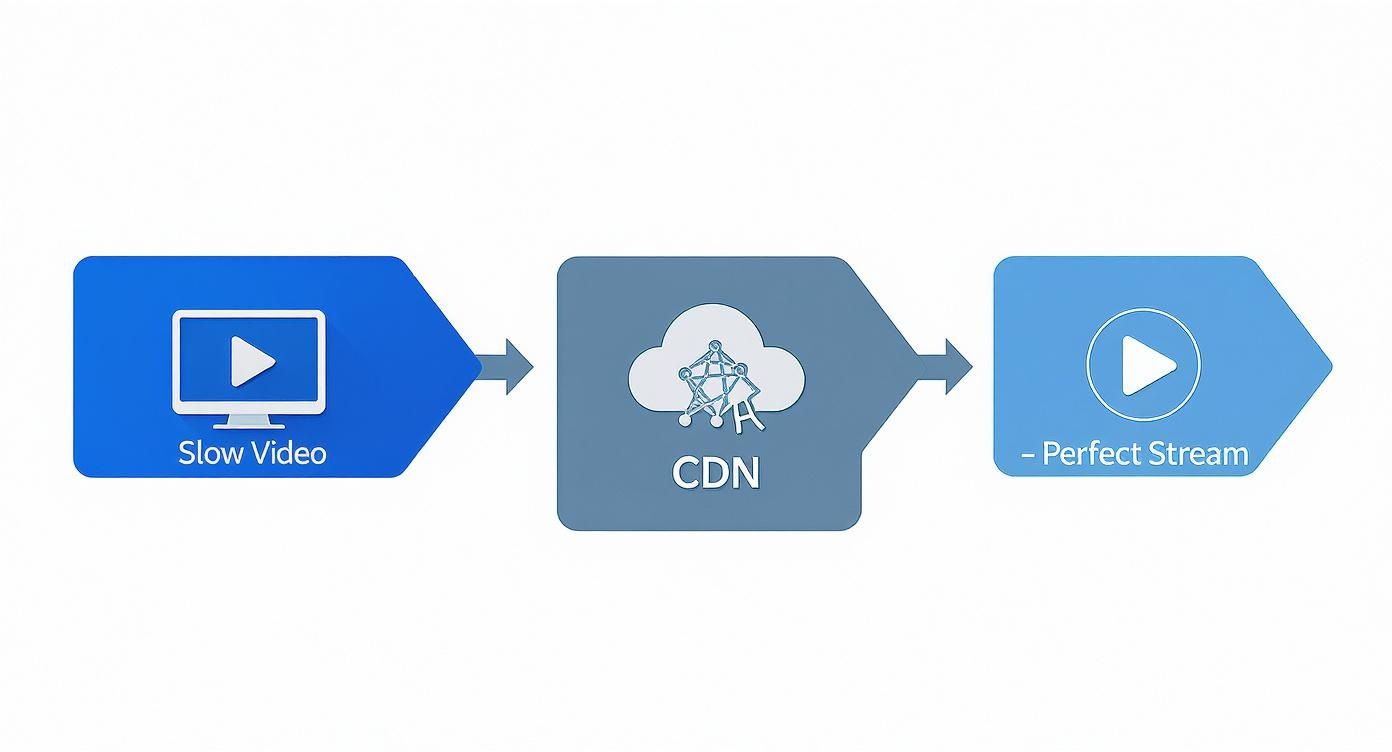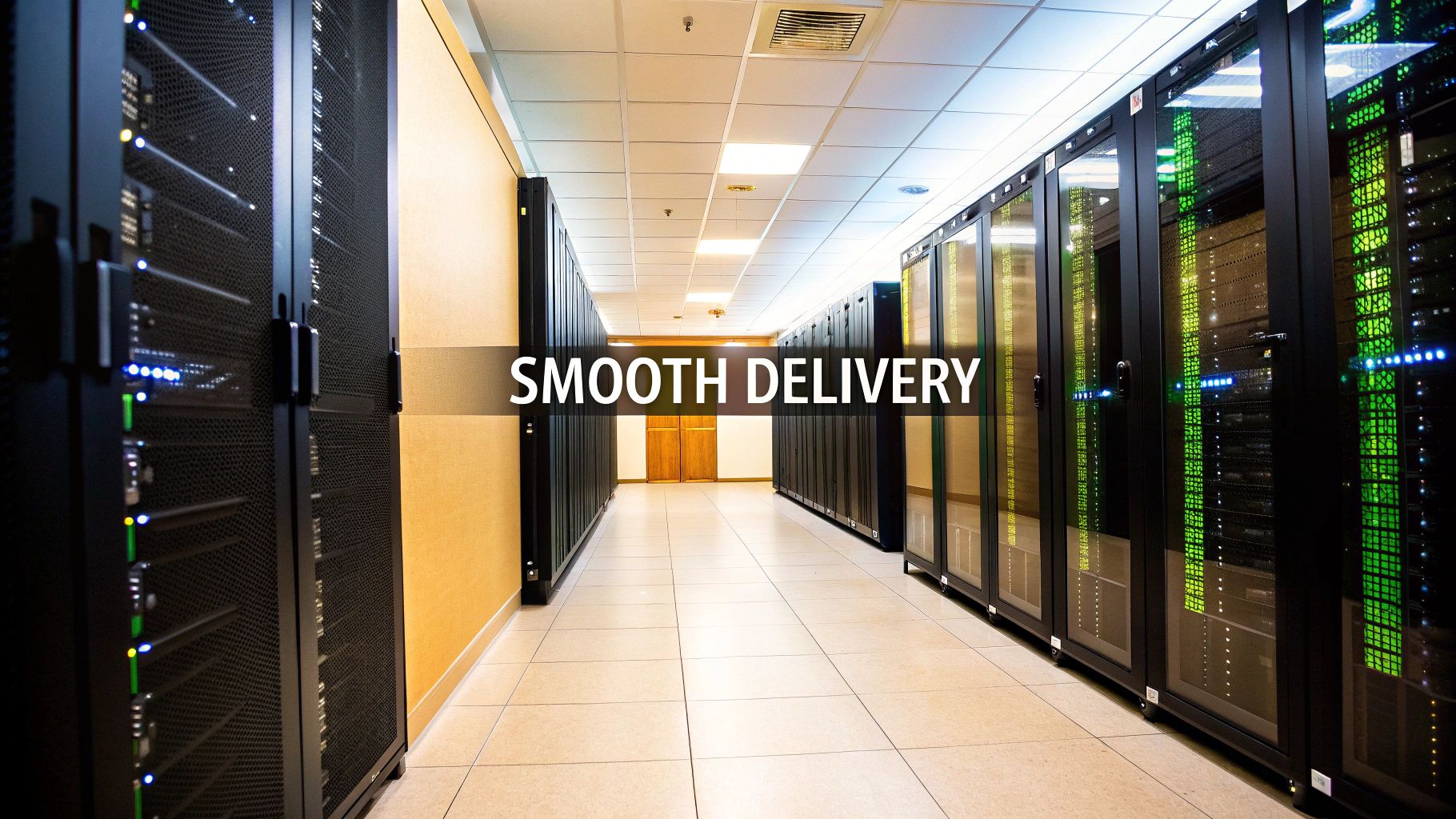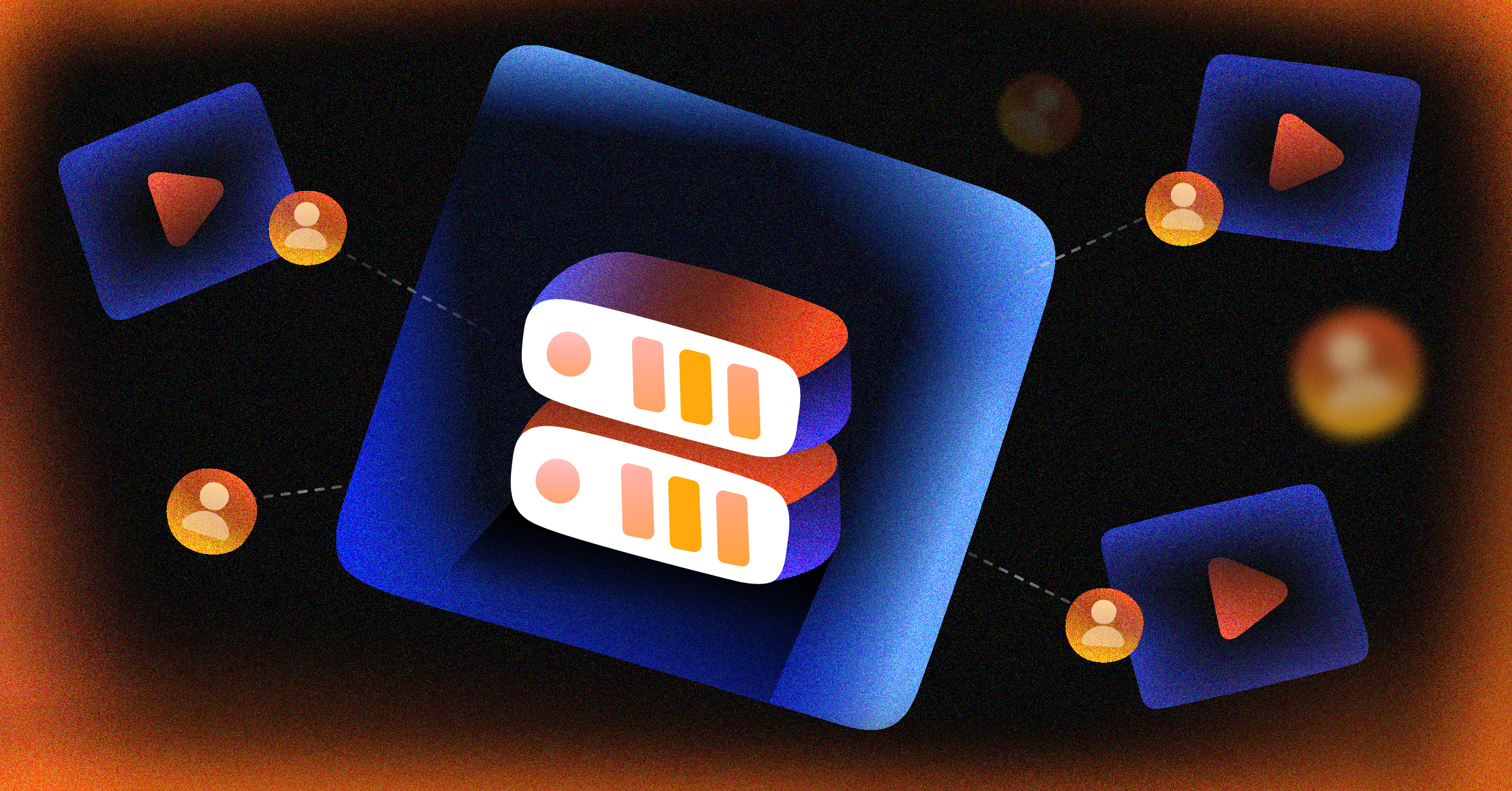We’ve all been there: you’re at the edge of your seat during a movie’s climax, or a live game is down to the wire, and suddenly… the spinning wheel of death. That dreaded buffering icon is the ultimate killer of viewer engagement. A Content Delivery Network (CDN) for streaming video is the behind-the-scenes hero built to stop this from happening, making sure your content gets to your audience fast and reliably, no matter where they are.
Why Slow Streaming Kills Your Content
Picture this: you’ve poured months into producing an amazing video series or orchestrating a huge live event. Your marketing was spot-on, and thousands of eager viewers are tuning in. But just as things get going, their screens freeze. That infamous buffering wheel pops up, and you can almost feel the viewers dropping off one by one. By the time the stream gets its act together, your audience has shrunk.
This isn’t just a bad dream; it’s the reality for creators who don’t think about their delivery infrastructure. When it comes to video streaming, every single millisecond of delay—what we call latency—tests your viewer’s patience.
The Problem of Distance in Streaming
The root of the problem is simple physics: distance. If your video is hosted on a single server, say, in New York, a viewer trying to watch from Tokyo has to pull that data from halfway across the planet. The farther the data travels, the more likely it is to run into internet traffic jams, lost data packets, and all sorts of frustrating delays.
This leads directly to the things viewers despise:
- Buffering: The video grinds to a halt while it waits for the next chunk of data to arrive. We dive deeper into the technical causes in our guide to buffering when streaming.
- High Latency: A noticeable lag between something happening live and when your audience actually sees it.
- Poor Video Quality: To keep playing, the video player might downgrade to a lower resolution, leaving your viewers with a blurry, pixelated mess.
Today’s audiences have zero patience for a bad stream. Research shows viewers start to leave after only two seconds of buffering, and for every extra second they have to wait, the abandonment rate jumps by another 6%.
The CDN Solution: A Global Stage
This is where a CDN for streaming video completely changes the game. Think of it like a massive concert tour. Instead of making every fan fly to one single stadium (your main server), you set up local stages in cities all over the world. When someone wants to see the show, they just go to the closest venue and get a perfect, front-row experience.
A CDN does the exact same thing for your video. It’s a distributed network of servers, known as Points of Presence (PoPs), placed in strategic locations worldwide. The CDN makes copies of your video—a process called caching—and stores them on these local servers.
So, when that viewer in Tokyo hits play, the CDN is smart enough to serve the video from a nearby server in Japan, not all the way from New York. This slashes the travel distance for the data, paving the way for smooth, buffer-free streaming and giving every viewer that flawless, front-row seat.
How a CDN Delivers a Perfect Stream
So, how does a Content Delivery Network manage to wipe out buffering and serve up a flawless video stream anywhere on the planet? It’s not magic, but it’s a brilliantly simple idea that boils down to one key principle: closing the distance between your content and your audience.
Let’s trace the path of a single video file. Picture your video sitting on an origin server—the one-and-only source for your content—located somewhere like New York. Without a CDN, every single viewer, whether they’re in London, Sydney, or just across town, has to send a request all the way back to that single server in New York. That long-haul trip is slow and often unreliable, which is exactly what causes the buffering we all despise.
A CDN for streaming video flips this model on its head. It builds a global network of smaller, local servers called Points of Presence, or PoPs. Think of these PoPs as mini-libraries for your content, strategically placed in major cities all over the world.
The Role of Caching and Smart Routing
The first time a viewer in Sydney asks for your video, the CDN jumps into action. It fetches the video from the New York origin server just once and saves a copy—a process we call caching—on the PoP server right there in Sydney.
This is where the real cleverness comes in. When the next person in Australia wants to watch that same video, the CDN’s smart routing system doesn’t bother going back to New York. Instead, it sends the request to the much, much closer Sydney PoP. The video data now travels just a few miles instead of thousands, which means playback starts almost instantly.
This completely changes the viewing experience, turning a slow, buffering mess into a perfect stream, just like this visualization shows.

The infographic nails it: a CDN acts as that crucial middle layer, grabbing those slow requests and transforming them into fast, dependable streams for viewers.
Handling Video Chunks for Seamless Playback
Modern video streaming doesn’t work by sending one giant file. Instead, videos are broken down into small, manageable pieces or “chunks,” each just a few seconds long. This is the foundation of adaptive bitrate streaming.
Your video player requests these chunks one after another to create a continuous, smooth playback experience. A CDN is perfectly designed for this job, as it can cache and deliver these tiny chunks with incredible speed from the nearest PoP. This efficiency leads to three huge wins:
- Faster Start Times: The first chunk of the video loads almost immediately because it’s coming from a server right around the corner.
- No Buffering: The player can easily stay ahead of the game, grabbing the next chunk long before the current one finishes.
- High Quality: A stable, fast connection to the local PoP gives the player the confidence to request high-resolution chunks without worrying about interruptions.
By breaking videos into segments and caching them globally, a CDN can reduce video startup times by over 80% and cut buffering incidents by more than 90%.
Preparing Your Video for the CDN
Before your video ever gets to the CDN, it needs to be prepped for delivery to all kinds of devices through a process called transcoding. This basically means creating multiple versions of your video at different resolutions and bitrates. This ensures that someone watching on a 4K smart TV and someone on a phone with spotty service both get the best stream possible for their situation. To get the full picture, it’s helpful to understand how video transcoding prepares files for optimal delivery across any platform.
At the end of the day, a CDN is like a sophisticated traffic cop for your video content. It looks at every viewer request, figures out the fastest and most reliable route, and serves the video from the closest possible spot. That distributed system is the secret sauce to scaling your streams to millions of viewers without ever compromising on quality.
The Real-World Benefits of a Video CDN
Knowing how a Content Delivery Network works is one thing, but seeing how that tech translates into actual business results is where things get interesting. When you look past the technical jargon, using a CDN for streaming video gives you some serious, game-changing advantages that directly improve your viewer’s experience, keep your service stable, and boost your bottom line. These aren’t just small tweaks; they’re the foundation of any solid video strategy.

Superior Performance and Viewer Retention
The first thing you’ll notice with a video CDN is a massive jump in performance. By serving your video from a local server close to the viewer, a CDN cuts latency to almost nothing and pretty much kills buffering. For the person watching, this means videos start instantly, play in crisp high quality, and don’t stutter to a halt.
This smooth experience isn’t just a nice perk—it’s absolutely essential for keeping people engaged. Viewers have zero patience for bad streams. A high-quality, seamless playback keeps them glued to the screen longer, which in turn increases session times and makes them far more likely to come back for more.
- Less Buffering: Say goodbye to that dreaded spinning wheel, which is the number one reason people give up on a video.
- Higher Watch Times: An uninterrupted stream means people will actually stick around to the end.
- Improved Brand Perception: When you deliver a professional, high-quality stream, you build trust and look credible.
Effortless and Automatic Scalability
Picture this: your new marketing video goes viral overnight, or your live product launch gets ten times the audience you planned for. Without a CDN, that traffic spike would hammer your single origin server, causing it to grind to a halt or crash entirely. Suddenly, every single viewer is cut off at the most critical moment.
A video CDN is your built-in safety net for this exact scenario. Its distributed network spreads the load across hundreds or thousands of servers around the world. If one server gets swamped, traffic is automatically sent to others that have capacity. This lets you handle huge, unexpected traffic surges without lifting a finger.
A CDN for streaming video gives you the power to go from ten viewers to ten million concurrently, without your infrastructure breaking a sweat. It transforms scalability from a major engineering challenge into a seamless, automatic process.
This ability to scale on demand is a must-have for live events, viral campaigns, or any growing platform. You never have to worry about your own success taking you down.
Rock-Solid Reliability and Uptime
What happens if your main server in New York has an outage? Without a CDN, your content is offline for everyone, everywhere. A CDN, on the other hand, is designed from the ground up for redundancy and reliability.
Because your video is cached on tons of servers across the network, a problem with one server—or even your main origin server—doesn’t have to cause a total blackout. The CDN can just keep serving the cached video from other healthy PoPs, keeping your stream online for most of your audience. This built-in failover system provides a level of uptime that a single-server setup could never hope to match.
Enhanced Content Security
Beyond just performance, a CDN also wraps your content in a crucial layer of security. The distributed network acts like a shield, protecting your origin server from direct attacks.
Key security benefits include:
- DDoS Mitigation: A Distributed Denial of Service (DDoS) attack tries to flood a server with junk traffic. A CDN can absorb and filter this malicious traffic at the edge of its network, so the attack never even reaches your server.
- Access Control: Many CDNs offer tools like token authentication or geo-blocking, which give you fine-grained control over who can watch your videos and from where.
This security is vital for protecting your valuable content and ensuring your service stays online and trustworthy. It’s no surprise that demand for this infrastructure is exploding. The global CDN market is projected to surge from USD 14.08 billion in 2025 to USD 60 billion by 2035, all thanks to the world’s insatiable appetite for high-quality video. You can read the full research about CDN market growth and see how nearly 60% of all internet traffic now relies on this critical technology.
Choosing the Right CDN for Your Video Content
Not all Content Delivery Networks are built the same, especially when you step into the demanding world of video. Picking the right CDN for streaming video isn’t about finding a single “best” provider. It’s about matching a CDN’s specific strengths to what you actually need to deliver.
This decision is a big one. It will directly shape your stream’s quality, how reliable it is, and whether it can handle a sudden flood of viewers.
Think of it this way: you wouldn’t use a sports car to haul lumber, and you wouldn’t enter a semi-truck in a Formula 1 race. In the same way, a CDN that’s great at delivering small website images will likely choke when faced with a high-definition live stream. You need a network engineered specifically for video’s unique challenges.

What to Look For in a Video CDN
As you start comparing your options, there are a few core features that should be at the very top of your list. These aren’t just nice-to-haves; they are the foundation for giving your audience a smooth, buffer-free experience, no matter where they are or what device they’re using.
When evaluating potential CDN partners, it’s helpful to break down the essential features into what they do and why they’re so critical for video.
Essential CDN Features for Video Streaming
| Feature | What It Does | Why It’s Important for Streaming |
|---|---|---|
| Global Network (PoPs) | Distributes your video content across servers worldwide, physically closer to your audience. | A larger, more spread-out network drastically reduces latency. Less distance means faster start times and way less buffering. |
| Modern Protocol Support | Natively handles industry-standard streaming protocols like HLS and DASH. | These are the universal languages of video streaming. Without them, you can’t reliably deliver video to every phone, tablet, and smart TV out there. |
| Adaptive Bitrate (ABR) | Automatically adjusts the video quality in real-time based on a viewer’s internet connection. | This is the magic that keeps a stream playing smoothly. If a viewer’s WiFi dips, ABR seamlessly drops the quality to prevent a stall, then raises it back up when the connection improves. |
| Real-Time Analytics | Provides a dashboard with live data on viewership, buffering events, geographic location, and more. | You can’t fix what you can’t see. Analytics give you the insights needed to troubleshoot issues and understand how your audience engages with your content. |
| Security Features | Includes tools like token authentication, geo-blocking, and DDoS mitigation to protect your streams. | This protects your valuable content from piracy, helps you enforce regional licensing deals, and keeps your service online during an attack. |
A CDN that delivers on all these fronts provides the horsepower and the intelligence you need for a professional-grade streaming service.
Analytics and Security Are Non-Negotiable
Beyond just delivering video files quickly, a top-tier CDN gives you the tools to understand your audience and lock down your content. These features turn your CDN from a simple delivery service into a vital part of your business strategy.
First off, real-time analytics are absolutely essential. You need a clear window into how your content is performing right now. This means tracking metrics like how long people are watching, how often they experience buffering, where your viewers are, and when your traffic spikes. This data is pure gold for refining your content and improving the viewer experience.
A CDN without solid analytics is like flying blind. It gets the video out the door but leaves you completely in the dark about who’s watching and whether they’re actually having a good time.
Just as critical are robust security features. Your video is a valuable asset, and it needs to be protected. Look for a CDN that offers:
- Token Authentication: Prevents hotlinking and unauthorized access by generating secure, one-time-use links for every viewer.
- Geo-Blocking: Lets you control who can see your content based on their country, which is a must for managing broadcast rights and licensing agreements.
- DDoS Mitigation: A powerful CDN can absorb massive denial-of-service attacks at the edge of its network, protecting your origin server and ensuring your stream stays live.
Finding the right CDN is a detailed process, but if you focus on these key pillars, you’ll be well on your way to a solution that can truly grow with you. For a detailed comparison of top providers, our guide on the best CDN for video streaming is a great next step.
Live Streaming vs. Video on Demand Delivery
When you’re picking a CDN for streaming video, the first thing you have to get straight is the massive difference between live streaming and video on demand (VOD). They might both be “video,” but delivering a live football game as it unfolds is a completely different beast than serving up a pre-recorded movie. Your entire CDN strategy hinges on which one you’re focused on.
Let’s use an analogy. VOD is like a giant public library. The books (your videos) are already written, cataloged, and sitting on the shelves. The library’s job is to manage a huge collection and have a slick system for getting those books into the hands of many different people, whenever they happen to show up.
Live streaming? That’s more like a breaking news broadcast. The event is happening right now. The single most important thing is getting that feed to millions of viewers at the same time, with virtually no delay. There’s no time to neatly file it away; you have to capture it and push it out in a heartbeat.
What a Video on Demand CDN Needs to Do
For platforms like Netflix or YouTube, where the content is a fixed library, the CDN’s main job is all about massive, efficient distribution. Once a video is uploaded, it’s not changing. This allows the CDN to get really smart about caching and storage.
Here’s what matters most for a VOD CDN:
- Deep Caching: When a movie gets popular, the CDN can store the entire file on its servers across the globe. This makes repeat views lightning-fast.
- Massive Storage: The network has to be built to hold colossal libraries of content—think entire TV series or blockbuster films—without breaking a sweat.
- High Throughput: A good VOD CDN can push an incredible amount of data to millions of people at once, especially during peak times like a Friday night.
What a Live Streaming CDN Needs to Do
Live streaming flips the whole model on its head. You can’t really “cache” a video that’s being created in real time. The file doesn’t fully exist yet. So, the focus shifts from storage to pure, unadulterated speed and real-time processing.
For live events, latency—the delay between something happening and the viewer seeing it—is the ultimate enemy. A few seconds of lag can spoil a game-winning goal or make interactive features feel totally out of sync.
A top-tier live streaming CDN absolutely must have:
- Ultra-Low Latency: The network has to be engineered from the ground up to move video from the source to the screen as fast as humanly possible, often using special protocols to shave off milliseconds.
- Real-Time Transcoding: The CDN might need to convert the live feed into different quality levels on the fly, which is essential for smooth adaptive bitrate streaming.
- Instant Scalability: It must handle a sudden, massive flood of viewers the second an event goes live, all without buffering or crashing.
This distinction is what’s fueling huge investments in specialized networks, especially in major markets. North America, for example, currently leads the global CDN market with a revenue share of over 31% in 2024, largely because of the streaming giants based there.
While VOD still makes up over 61% of the streaming market, the live streaming segment is growing at an incredible 14.8% compound annual growth rate. This boom is driven by sports, concerts, and live events that demand a perfect, real-time experience. You can discover more insights about the CDN market’s growth to see how these trends are shaping the technology.
Ultimately, choosing a CDN comes down to this: do you need a world-class library or a world-class broadcast network?
Got Questions About Video CDNs? We’ve Got Answers.
Even with a solid grasp of the basics, a few practical questions always pop up when it’s time to actually use a CDN for video streaming. Let’s tackle some of the most common ones to clear up any confusion and help you move forward.
Think of this as the final check-in before you take off.
Can I Just Use a Regular CDN for Video?
You technically can, but it’s a bit like using a family sedan to move a piano. It might get the job done, but it’s not going to be pretty. Standard CDNs are fantastic at delivering static website files—things like images, CSS, and JavaScript. They’re built to cache small, predictable files to make websites load faster.
Video streaming is a completely different beast. It’s about delivering massive files as a continuous stream of tiny data chunks. A proper video CDN is built from the ground up for this, with built-in support for adaptive bitrate streaming (HLS/DASH) and features designed for super-low latency. Using the wrong tool for the job is a surefire way to end up with the exact buffering issues you were trying to fix.
How Is a CDN Going to Affect My Budget?
While adding a CDN does introduce a new line item to your expenses, it almost always pays for itself. Pricing is usually based on how much data you transfer (in gigabytes or terabytes), and sometimes there’s a small fee per request.
But here’s how a CDN actually saves you money:
- It slashes your origin server costs. By handling the vast majority of viewer traffic, the CDN dramatically reduces the load on your main server. That means you’ll pay your hosting provider a lot less for bandwidth.
- It keeps your audience watching. A smooth, buffer-free stream keeps viewers engaged. More engagement means more ad revenue, more subscriptions, and happier customers who stick around.
Don’t think of a CDN as just another cost. It’s an investment in your user experience. The money you lose when a frustrated viewer clicks away is almost always more than what you’ll spend on a solid delivery network.
What’s a Multi-CDN Strategy All About?
A multi-CDN strategy is exactly what it sounds like: using two or more CDN providers at the same time to deliver your video. This is the ultimate setup for reliability and performance.
If one CDN experiences a regional slowdown or a complete outage, your traffic is automatically shifted to another provider without your viewers ever noticing a hiccup. It’s about building a system with no single point of failure.
This approach was once reserved for massive broadcasters, but it’s becoming more common for any streaming service where downtime is simply not an option. It ensures your stream stays live and can even route viewers to the best-performing network for their specific location in real-time.
Ready to deliver a flawless streaming experience without the complexity? LiveAPI integrates with world-class CDNs to provide a powerful, developer-friendly video platform. Build and scale your video application with our robust APIs and reliable infrastructure. Get started with LiveAPI today.









